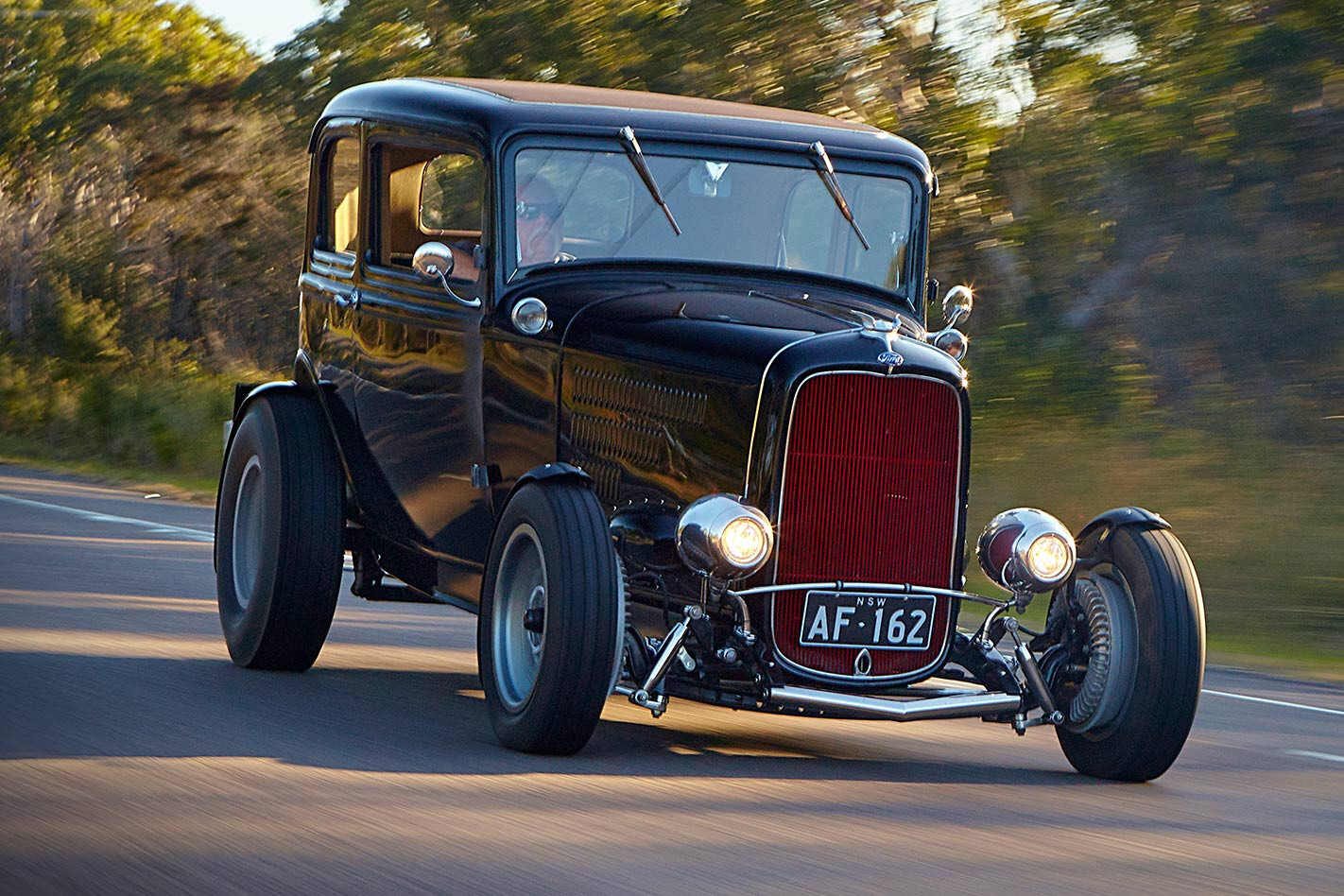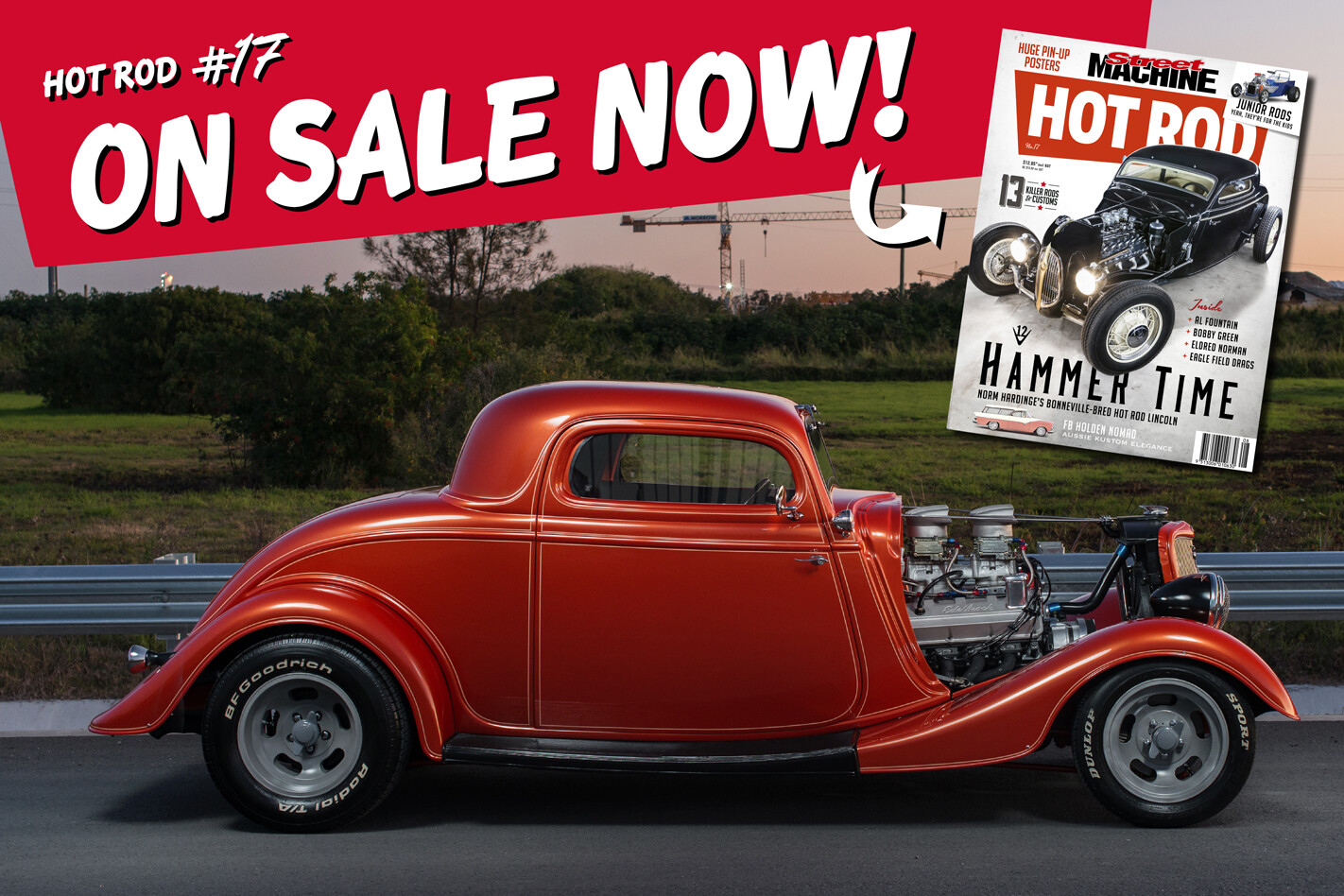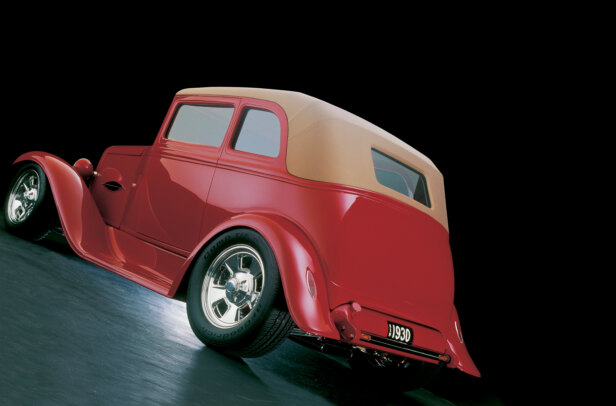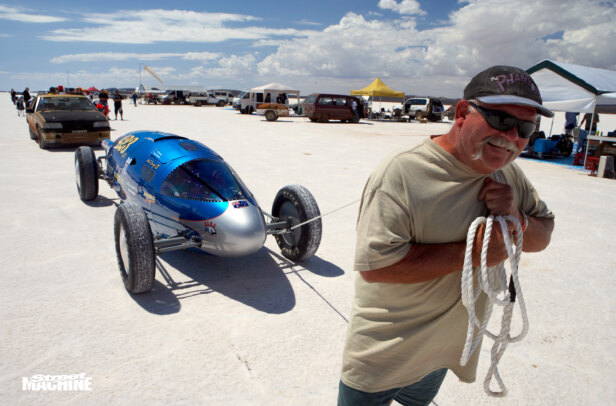Veteran hot rodder Alan Fountain’s been cutting up old cars for almost 50 years, but he left this one as Henry intended
This article on Al’s 1932 Ford Victoria was originally published in issue no.17 of Street Machine’s Hot Rod magazine
SOME folk build cars for show but most of us build them to drive. Alan Fountain is with the majority, and after the best part of 50 years getting his hands dirty can look back at an impressive resume of standout cars. Some have been seriously quick; he has run as fast as 235mph (378km/h) in his B-52 belly tank on Lake Gairdner and 7.20sec@191mph in his Wild Bunch drag racer. But his first love is hot rodding and he’s spent a lifetime attending events all over the eastern half of Australia, as often as not catching the eyes of magazine editors with no fewer than six of his builds — seven if you count a Yamaha XS650 bobber — being featured over that time.
This tidy 1932 Ford Victoria makes eight, and like all the others was built by Al in a modest backyard shed on the NSW Central Coast. Typically it came to our attention a thousand kilometres from home; Al and a mate had driven down to Castlemaine in Victoria for the Boogaloo Invitational just the day before, in company with a Model A closed-cab pick-up and a pair of ’32 three-window coupes. Yep, 980 kilometres in one day — 12 hours point to point — and much of it in teeming rain. He described it simply as a great drive and good fun. “It’s a good little car,” he says.
Al has had the Vicky on the road for six or seven years, following a 12-month build after acquiring the body from Michael Sechos in Sydney a few years before that. The body is something special; a complete, rust-free, original steel shell initially sourced in the US by Geoff Dellow and imported to Australia in the early 1990s. “It changed hands a few times before Michael rescued it from being cut down the middle and widened,” Al says. Not usually averse to cutting up old cars — Al was an early adopter when he chopped four inches out of the family ’32 sedan 40 years ago — this one was too valuable to even consider it.
“Some you can’t just cut up,” he says. “The body is exactly as I got it from Michael — he had it as a semi-restored car — and I haven’t even repainted it; all I did was put in new glass and Bailey channels. I made new bonnet sides with blisters to clear the engine and got Dennis Harkness to punch the louvres in. But I’ve still got all the original fenders and running boards, all steel. A restorer could buy this car and just lift the body off the chassis.”
Instead, the Victoria gets its visual hot rod swagger from its aggressive stance and tasty blend of wheels, tyres and accessories. An original pair of frame rails was dispatched to Geoff Brown to set up in his jig, including boxing the chassis and adding cross-members for strength. Al then attended to the suspension which is mostly Rod-Tech gear, including transverse spring, 4.5-inch drop axles, urethane bushes, coil-over shocks and ’36 hairpin radius rods. “All their stuff’s really good,” Al says. An HQ steering box points him in the right direction, controlled by a Limeworks steering column from California.
Not everything has to be polished to look cool. The rears are 16×6 magnesium Halibrands but the fronts are alloy versions that have been painted to match. The big and little combo is exaggerated with a fair amount of rubber rake
Brakes are 12in drums, Ford on the front with finned covers and Buick on rear with finned backing plates that Al and his son Craig manufacture in occasional limited runs. They look the business, especially teamed with the large-diameter rims and high-profile rear tyres that give the rod its killer road presence. “The rear wheels are an original set of 16x6in magnesium Halibrands that I picked up at the Bendigo Swap 13 years ago; they were undrilled when I got them,” Al says. “The fronts are 15×4.5in alloy Halibrands painted to match the colour.” Front tyres are 165×15 Vredestein radials and the rear 8.90x16in grooved Firestone Dirt Tracks. Al hasn’t had it sideways in the mud yet but he says the Firestones and the minimalist cycle-style mudguards had no problem handling the worst of the weather on the run to the Boogaloo.
We don’t see a lot of early Ford Victorias in Australia, especially with steel bodies, which makes this one distinctive enough, but the original grille painted bright red and 1920s Edmunds & Jones (E&J) Type 20 torpedo headlights make it stand out even more. The lights are actually reproductions which Al and Craig also manufacture locally in small batches. A more subtle mod is the Vintique 14-gallon petrol tank strapped on the back in place of the original 10-gallon tank, in keeping with the car’s role as a practical touring street rod.
It’s not a Hemi, but it hangs out the side of the engine bay just the same. While these are polyspherical heads, they’re much rarer than the 318 Polys because they were often replaced by Hemi heads
Lift up the bonnet sides and it all gets a whole lot more interesting than your everyday small-block Ford or Chev. “Everyone’s got a belly button,” Al says of his left-field choice. “Craig and I just like Chryslers from the days of mucking around with Hemis in the race car and we’re fully Chrysler now.” The pair later got into wide-block Poly V8s (as fitted to a gazillion Dodge Phoenixes) when no-one else wanted them — Craig’s got one in his Buick and Al has another lined up for a Model A coupe currently in the build — but this particular Poly is a totally different bucket of bolts and something of a rare bird in Australia.
Manufactured from 1955 to 1957 in capacities from 301 to 354 cubic inches and originally fitted to the Chrysler Windsor, the Spitfire Poly engine is a cross between a Hemi block and bottom end, and an early version of the later Polyspheric heads with their dual-domed combustion chambers and simpler (cheaper) single rocker set-up. In fact, Hemi heads bolt straight back on, which is what a lot of people looking for extra performance did and still do, making the original Spitfire Poly heads even rarer today.
“I’ve got a pallet load of Hemi heads out the back,” Al says, “but I thought it was more unique to leave the Poly heads on. (Trouble is) no-one made speed equipment for them so Craig and I made the valve covers ourselves.” Which makes it even more unique, of course. For similar reasons, the inlet and exhaust manifolds are stock, although the carburettor has been upgraded to a 500cfm Carter Competition Series and the ignition system to Mopar Performance electronic. This particular motor is a 301 from 1955, but is fitted with an Isky cam made for a 354, which does away with the fuel pump drive at the front and shortens the length of the engine by three inches, handy when you’re trying to shoe-horn a V8 into an engine bay designed for four cylinders. Apart from that and the gold engine paint, she’s as stock as a rock, with Al reporting no problems sourcing standard parts from the US.
The interior is pretty bare bones and not far removed from stock, although Al does like to drive his cars, so the seats are narrowed Hyundai Excel units. There’s no rear seat, which makes it a good place to put luggage.
The Carter four-barrel was one of a pair off a big-block in the shed, and was initially fitted only to do a trial start-up of the engine. “I’d made a set-up with four 97s for it but it ran so sweet with the little Carter I never fitted them,” Al says. “It’s unreal on fuel (91 unleaded); we went from home to Castlemaine for $120.” With 31in-tall tyres, “it’s not working real hard on the highway and is probably only doing 2000 revs,” even with 3.5 diff gears. Hooking it all up is a Turbo 350 with Hot Heads adapter plate, while Al’s own four-core radiator keeps everything cool.
The interior is largely as Al got it, apart from Hyundai Excel bucket seats (narrowed 30mm and trimmed by John Viles), Auto Meter gauges in the standard dash and a Gennie shifter. “I never got around to doing the rest of the trim,” he says. “I just wanted to leave it ‘old looking’.” He dispensed with the rear seat altogether, converting it to a spacious and regularly-used cargo deck.
“My wife Ellen supports my habit — we’ve been together since 1969 — and there’s plenty of room for the two of us, our gear and an esky,” he says. They’re recently back from a week visiting hot rod friends around Tumut and the little Vicky has also made it to Chopped, numerous trips to Gippsland and countless runs throughout regional NSW.
I rode shotgun with Al during the photo shoot and it was immediately obvious how well the car suits its intended purpose. With the full-height roof and low bucket seats, it’s less cramped than most and rides very well, not crashing over bumps like some and with a welcome absence of rattles and squeaks. With Dynamat underfloor and well-sealing windows, it’s a quiet and comfy ride for an 84-year-old car with just enough exhaust note burbling through to remind you it’s a V8 doing the work. And weighing in at just 1200kg, it accelerates hard and stops on a dime.
“It drives real easy,” Al says. “I just wanted a good highway cruiser and the car is exactly that.”
ALAN’S CARS
Alan says the key to building a cool hot rod is proportion. Some people spend fortunes but if the bits don’t gel, it’s money wasted. If the number of his cars that have featured in magazines is any guide, he should know.
Al bought his first street rod in the mid-70s, a 1932 Ford four-door sedan (above) powered by a small-block Chev. “We sold our street car and the ’32 was our only car for a while,” he says. “Ellen used to take the kids to school in it.” He soon had it looking schmick enough to make the pages of Australian Street Rodding before turning his attention to a ’32 C-cab truck (below) powered by the engine out of Ellen’s XR Falcon.
If you’re thinking he married well, you’re not wrong. The truck made the cover of Custom Rodder, even as Al used it as his daily while he chopped four-inches out of the family Fordor. “I had it looking pretty neat,” he says, good enough in fact for a second feature in Street Rodding when it was done.
His next build was his most radical, a blown small-block ’27 roadster called Hot Cargo (above) hat he built to his own design, complete with his own coil-over suspension, wheelie bars, rear wing and parachute. It made him few friends in the ASRF — “I’d read the rule book, they had to pass it,” he says — and also the pages of Street Rodding, this time also scoring the cover.
Al then got the itch to go drag racing and, not one to do things by halves, joined the travelling Wild Bunch crew, which later morphed into Group One Doorslammers (above).
Priced out of the game, he returned to street rodding with a 440-powered ’32 roadster (above) with a paint job inspired by a 1932 Gee Bee racing plane, which he finished in 1998. It too made the cover of Street Rodding, alongside a chopped 1949 Studebaker pick-up (below) that Al had built in the meantime as his parts chaser. The roadster also later appeared in the 2009 Street Machine Hot Rod Annual.
Tight for space in his backyard shed, Al has in recent years built a trio of Yamaha XS650 hard-tail bobbers, one of which has already made the pages of custom bike magazine Retrobike. To meet Alan Fountain, he’s the last bloke to draw attention to himself, but chances are you already know his work.
ALAN FOUNTAIN
1932 FORD VICTORIA
Paint: Black acrylic
MILL
Type: 1955 Chrysler Spitfire V8
Capacity: 301ci
Inlet manifold: Stock four-barrel
Carburettor: Carter Competition 500cfm
Exhaust manifold: Stock
Exhaust: Two-inch exhaust by owner, hot dog mufflers
Rocker covers: Al and Craig Fountain
Camshaft: Isky hydraulic Crank, rods, pistons: Stock
Oil pump: Melling
Fuel pump: Carter
Ignition: Mopar Performance
Radiator: Owner
TRANSMISSION
Box: Turbo 350
Converter: 2200rpm stall
Adaptor plate: Hot Heads
Diff: Ford 9-inch, shortened by owner, 3.5:1 gears
Tailshaft: Shortened
BENEATH
Front suspension: Rod-Tech transverse spring, 4.5-inch drop axles, ’36 hairpin radius rods, urethane bushes
Rear suspension: Shortened nine-inch, Rod-Tech coil-overs
Steering: HQ Holden with Limeworks column
Front brakes: 12in Ford drums with custom finned covers
Rear brakes: 12in Buick drums with custom finned backing plate
ROLLING STOCK
Front: 15×4.5in alloy Halibrands with Vredestein 165x15in radials
Rear: 16x6in magnesium Halibrands with Firestone 8.90x16in Dirt Tracks





Comments